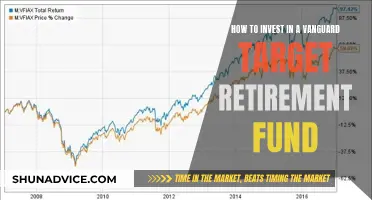
Investing in mutual funds is a great way to build a diversified portfolio without the hassle of picking and choosing individual investments. They are a popular investment choice, especially for retirement accounts, as they allow investors to benefit from the stock market's high average annual returns.
Mutual funds are an excellent option for those who don't want to select individual investments but want to benefit from the market's historical performance. They are also a good choice for those who want to invest in a variety of assets at once.
1. Decide on your investment goals: Determine whether you are investing for the short-term or long-term. If you are saving for a goal that is decades away, stock mutual funds are a great choice. If you are saving for a shorter-term goal, a bond market mutual fund or a high-yield savings account might be better options.
2. Pick the right fund strategy: If you are investing for the long-term, your mutual fund allocation should be focused on stock-based funds for more significant investment growth. For mid-term goals, balanced mutual funds that invest in both bonds and stocks can help reduce the risk associated with stocks. For near-term goals, focus more on bond funds to produce a steady income through interest payments.
3. Research potential mutual funds: Use tools like the Mutual Fund Observer and Maxfunds to research different mutual funds. Compare past performance to similar funds or benchmark indices, consider expense ratios, and try to avoid load fees or commissions.
4. Open an investment account: You may already have access to mutual funds through an employer-sponsored retirement plan, such as a 401(k). If not, you can open an individual retirement account (IRA) or a taxable brokerage account to invest in mutual funds.
5. Purchase shares of mutual funds: Make sure you have enough money deposited in your investment account, as mutual funds often have higher investment minimums than other asset classes. You can buy mutual funds through online brokers or directly from the fund company.
6. Set up a plan to keep investing regularly: Investing is not a one-off event for most people. Set up recurring investments to help grow your wealth and pay less per share over time.
7. Manage your portfolio: Rebalance your portfolio annually to ensure it aligns with your diversification plan and risk tolerance.
Remember, investing in mutual funds carries risks, and you can potentially lose money. Always do your research and understand the fees and expenses associated with the funds before investing.
| Characteristics | Values |
|---|---|
| Investment goals | Long-term goals such as retirement or short-term goals such as buying a home |
| Investment strategy | Active (trying to beat the market) or passive (trying to mimic the market) |
| Investment account | Individual retirement accounts (IRAs), taxable brokerage accounts, education savings accounts |
| Investment amount | Minimum investment amount varies, but can be as low as $100 or ₹500 |
| Investment type | Stock mutual funds, bond mutual funds, money market mutual funds, or hybrid funds |
| Investment research | Compare past performance, expense ratios, load fees, and management style |
| Investment purchase | Buy through a brokerage account or directly from the fund company |
| Investment timing | Buy at the end of each trading day based on the net asset value (NAV) |
What You'll Learn

Set clear financial goals
Setting clear financial goals is an essential step in achieving monetary safety, stability, and fulfillment. Here are some tips to help you set clear financial goals for investing in mutual funds:
Assess Your Current Financial Situation
Before setting financial goals, it's crucial to understand your current economic status. This involves evaluating your income, expenses, assets, liabilities, debts, savings, and investments, including any associated risks. By doing so, you can identify areas for improvement and explore new opportunities.
Identify Short-Term, Mid-Term, and Long-Term Goals
Financial goals can be categorized into three main types: short-term (less than 3 years), mid-term (3 to 5 years), and long-term (5 years or more). Short-term goals may include saving for a vacation or an emergency fund, while mid-term goals could involve buying a house or education. Long-term goals often revolve around wealth accumulation and retirement planning.
Make Goals Specific, Measurable, Achievable, Relevant, and Time-Bound (SMART)
To ensure your financial objectives are clear and realistic, apply the SMART framework. Make your goals specific and well-defined, quantifiable or measurable, achievable and realistic, relevant to your dreams and values, and time-bound with a defined deadline. This approach helps maintain focus and discipline in your financial journey.
Prioritize Goals Based on Importance and Urgency
Not all financial goals carry the same weight. Prioritize your goals by sorting them into lists based on their significance and urgency. This prioritization will guide the allocation of your resources, ensuring that you focus on the most critical objectives first.
Develop a Budget
Creating a budget is a powerful tool for achieving your financial goals. It enables you to monitor your income and expenses, identify opportunities for savings, and ensure that you're setting aside sufficient funds to work towards your targets. A budget helps you stay disciplined and make informed financial decisions.
Automate Savings and Investments
Automating your savings and investments is a convenient way to stay on track. Set up automatic transfers from your bank account to your investment and savings accounts. This removes the temptation to spend your money elsewhere and ensures consistent contributions toward your financial goals.
Stay Flexible and Adjust as Needed
Life is full of surprises, and circumstances can change. Be prepared to adapt your financial plans and goals as your personal or economic situation evolves. Regularly review and adjust your strategies to align with any changes in your life.
By following these steps, you can set clear and achievable financial goals, providing direction and focus for your investment journey. Remember, achieving financial success is a continuous process that demands commitment, discipline, and flexibility.
Schwab Fund Investment: A Beginner's Guide to Getting Started
You may want to see also

Choose the right account type
There are several account options for investing in mutual funds, and the choice will depend on your specific goals. Here are some of the most common types of accounts for investing in mutual funds:
- Standard brokerage account: Investors can open a standard brokerage account through an investment company or bank. This type of account offers a wide range of investment options, including stocks, bonds, and mutual funds.
- 401(k): If your employer offers a retirement savings plan, you may already have a 401(k). These tax-advantaged retirement accounts are common and often include mutual funds as the primary investment option.
- Traditional Individual Retirement Account (IRA): If your employer doesn't offer a retirement plan, you can open a traditional IRA at most investment companies. IRAs offer tax advantages and a wide array of investment options.
- Roth IRA: Roth IRAs are another option for retirement savings. They are funded with after-tax dollars, allowing your contributions to grow tax-free.
- Taxable brokerage account: Taxable brokerage accounts lack the tax benefits of retirement accounts but offer the flexibility to make withdrawals at any time without penalties. This makes them well-suited for goals you want to achieve before reaching retirement age.
- Education savings accounts: If you want to save for your children's college education, you can open a 529 college savings account and invest in mutual funds.
When choosing an account type, it's important to consider your investment goals, time horizon, and tax implications. Each type of account has its own advantages and disadvantages, so be sure to research and understand the features of each option before making a decision.
Climate Fund Investment: Steps to Take Action
You may want to see also

Decide on the right mix of stocks and bonds
When deciding on the right mix of stocks and bonds, it's important to consider your goals, risk tolerance, and time horizon. Here are some factors to help you determine the appropriate mix:
- Time Horizon: If you're investing for the long term, such as for retirement or your child's education, you may want to allocate a larger portion of your portfolio to stocks, as they tend to provide higher returns over the long run. On the other hand, if you're nearing retirement or have short-term goals, consider increasing your bond allocation to reduce risk.
- Risk Tolerance: Assess your comfort level with market volatility. If you have a higher risk tolerance, you may be comfortable with a higher allocation of stocks. However, if you're more risk-averse, consider a larger proportion of bonds, as they are generally considered less risky.
- Age: A common rule of thumb is to subtract your age from 100 or 110 to determine the percentage of your portfolio that should be allocated to stocks. For example, if you're 30 years old, you may consider allocating 70% to stocks and 30% to bonds. As you get older, gradually adjust your portfolio to increase your bond allocation.
- Financial Situation: Consider your financial circumstances and job security. If you have a steady and reliable income, you may have a higher tolerance for stock market risk compared to someone in a less stable financial situation.
- Psychology: Ask yourself if you are disciplined or emotional when it comes to investing. If market downturns make you want to sell your investments, consider holding a smaller proportion of stocks, as frequent trading based on emotions can impact your returns.
- Performance and Returns: Evaluate the historical performance and expected returns of stocks and bonds. Stocks typically offer higher potential returns but come with higher risk. Bonds, on the other hand, provide more stable and predictable returns but with lower yields.
- Tax Implications: Understand the tax implications of stocks and bonds. Profits from selling stocks are subject to capital gains tax, while bond interest payments are usually taxed as regular income. Consider the tax efficiency of each investment type when determining your allocation.
Remember, there is no one-size-fits-all approach to deciding the right mix of stocks and bonds. It's important to consider your personal circumstances, goals, and risk tolerance to create a portfolio that aligns with your investment strategy.
Passive Index Funds: A Simple Guide to Getting Started
You may want to see also

Pick an investment strategy
Picking an investment strategy is a crucial step in investing in mutual funds. Here are some key considerations for choosing the right investment strategy:
- Time Horizon: The first step is to determine your investment time horizon, which is how long you plan to hold the mutual fund. This will help you decide on the appropriate mix of stocks and bonds in your portfolio. If you're investing for the long term, you can afford to take on more risk by investing a larger portion of your portfolio in stocks. On the other hand, if you're investing for the short term, you may want to consider more conservative investments like bonds or money market funds.
- Risk Tolerance: Different mutual funds come with different levels of risk. It's important to assess your risk tolerance, which is your ability to handle fluctuations in the value of your investments. If you have a high risk tolerance, you may be comfortable with more aggressive investment strategies. However, if you have a low risk tolerance, you may prefer more conservative strategies.
- Investment Goals: Clarify your investment goals before choosing a strategy. Are you investing for retirement, saving for a down payment on a house, or funding your child's education? Each goal will have different time horizons and risk profiles, which will influence your investment strategy.
- Active vs. Passive Management: Mutual funds can be actively or passively managed. Actively managed funds have portfolio managers who actively select investments and aim to beat the market. These funds typically have higher fees. Passively managed funds, or index funds, aim to replicate the performance of a specific market index and usually have lower fees.
- Fund Performance and Fees: When evaluating mutual funds, consider their historical performance, expense ratios, and management fees. Compare the fund's performance over the last three, five, and ten years to the S&P 500. Also, look for funds with low expense ratios and management fees, as these will eat into your returns.
- Diversification: Diversification is a key principle in investing. When selecting a mutual fund, ensure that it invests in a diverse range of assets and sectors to reduce risk. Avoid overlapping or redundant holdings, as this can dilute your returns.
- Rebalancing: Regularly review and rebalance your portfolio to ensure it aligns with your investment goals and risk tolerance. This may involve buying or selling fund holdings to maintain your desired asset allocation.
Index Funds: Where to Start and What to Know
You may want to see also

Research mutual fund companies
When researching mutual fund companies, it's important to consider a few key factors. Firstly, look at the fees charged by the company. Mutual funds typically charge annual fees, expressed as a percentage of your investment, known as the expense ratio. Lower expense ratios are generally preferable as high fees can eat into your returns over time. It's also worth noting that actively managed funds, which aim to beat the market, tend to charge higher fees than passively managed funds, which aim to mimic the market.
Secondly, research the performance of the mutual fund company. While past performance doesn't guarantee future results, it can give you an indication of how well the company is meeting its goals. Compare the performance to similar mutual funds or benchmark indices.
Thirdly, consider the regulatory history of the company. Check the company's SEC filings to identify any regulatory issues. Choosing a larger, well-known company with a clean regulatory record can help reduce the risk of potential issues.
Some popular mutual fund companies include Vanguard, Fidelity, and American Funds (owned by Capital Group). These companies offer a wide range of funds, including actively and passively managed funds, and have a strong presence in the market.
Additionally, you can utilise tools like the Mutual Fund Observer and Maxfunds, as well as brokerages' websites, to research and compare different mutual fund companies. These tools can provide detailed information and help you make an informed decision.
A Simple Guide to Mutual Funds: Investing Your First $100
You may want to see also
Frequently asked questions
Some good mutual funds to invest in right now include the Vanguard Wellington Fund (VWELX), Fidelity 500 Index (FXAIX), and the Vanguard Total Stock Market Index Fund (VTSAX).
Start with your savings goals to get an idea of how aggressive you want your investments to be based on your risk tolerance and how long you'd like your money to be invested. Then, determine the best asset allocation for your goals and select a mutual fund to help build your diversified portfolio.
Mutual funds are a great way to build a diversified portfolio without a lot of extra cost or hassle. They are also a good option for people who don't have the time, education, money, or willingness to manage a large portfolio of investments.
Index funds, also known as passively managed funds, are built to follow a market benchmark like the S&P 500 Index. Active funds, on the other hand, are managed by fund managers who handpick the fund's investments in an attempt to beat the market.
You can invest in mutual funds by opening a brokerage account and investing in individual stocks, bonds, or other securities. You can also participate in an employer-sponsored retirement plan, such as a 401(k) or IRA, which often includes mutual funds as an investment option.







